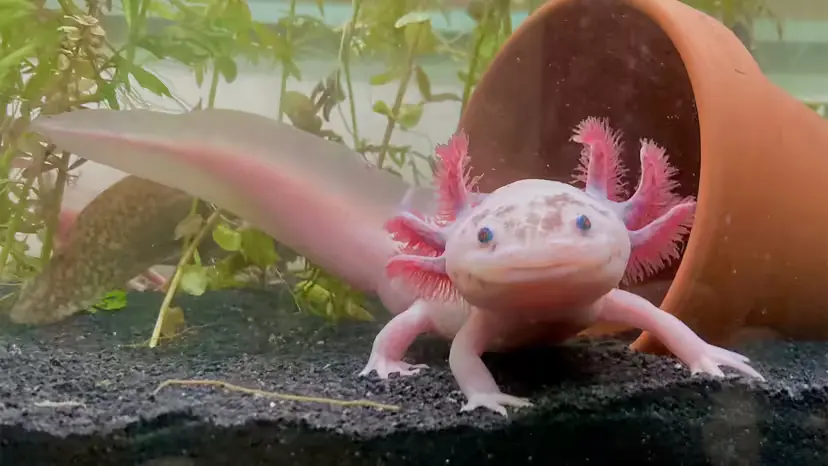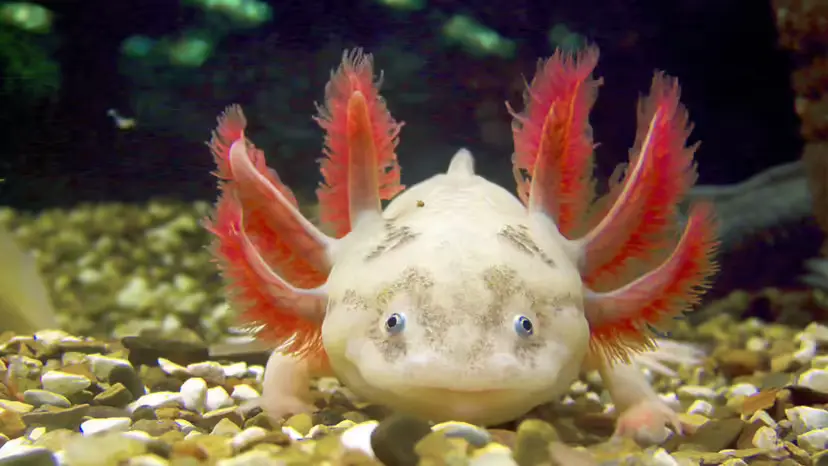Common names: Axolotl, Mexican axolotl (often miscalled “Mexican walking fish”)
Scientific name: Ambystoma mexicanum
Group: Amphibia → Caudata (salamanders)
Wild stronghold: Lake Xochimilco wetland–canal system, southern Mexico City
Keywords: Neoteny (juvenile traits kept in adults), external gills, fully aquatic, extreme regeneration

Historic range: The former lake complex of the Mexico Basin.
Today: Almost entirely restricted to Lake Xochimilco and its canals/wetlands.
Microhabitat: Shallow, vegetated waters with year-round flow, cover, and good oxygen—lagoons, backwaters, reed beds.
Reminder: Axolotls are amphibians, not fish.
Neoteny explains it: Adults keep feathery external gills, a fin-crested tail, and a round, “smiling” head.
Colors: Wild axolotls are typically dark brown/black with speckles. Captive lines commonly show leucistic or albino morphs.
Built for water: Small webbed feet + a long, finned tail = tadpole-like propulsion rather than land travel.
Why stay “baby-like”? Their ancestral habitat was stable and permanent, with relatively few aquatic predators, so evolving a land phase wasn’t necessary—keeping the juvenile body plan was efficient.

Lifespan: 10–15 years in captivity; ~5–6 years in the wild due to stressors.
Maturity: ~1 year.
Season: Courtship peaks around February. Males signal with pheromones and a tail-wagging dance.
Fertilization: The male deposits a spermatophore; the female picks it up for internal fertilization.
Eggs & care: Females attach hundreds of eggs to plants/rocks; no parental care. Newly hatched larvae may nip siblings’ limbs—which later regrow.
Trophic role: Historically among the top aquatic predators in the valley’s lakes/canals.
Diet: Worms, mollusks, aquatic insects and larvae, and small fish—captured via rapid suction feeding.
What they can regrow: Limbs, tail, heart tissue, parts of the eye, spinal cord, and even portions of the brain—with minimal scarring.
How (plain-English version): After injury, tissues revert to an embryonic-like program, then rebuild the missing part with the right patterning.
Big caveat: If forced to metamorphose (e.g., with thyroid hormones/iodine), axolotls lose much of that regenerative power.
Why it matters: They’re a flagship model organism for regeneration and scar-free healing research.
Invasive fish: Tilapia and various perches eat eggs/larvae and compete for food.
Pollution & hydrology: Wastewater, agro-runoff, and habitat fragmentation degrade canals and wetlands.
Conservation status: Critically endangered in the wild; densities have plummeted.
What’s being done
Chinampa restoration: Re-creating traditional floating-garden islands (aquatic vegetation + wood frames + lake mud) to filter water, add cover, and provide spawning/nursery habitat.
Invasive control & eco-farming: Reduce non-native fish and nutrient inputs via low-input agriculture.
Community stewardship & ecotourism: Guided visits to chinampas fund restoration and build local pride.
Captive boom: Labs and aquarists maintain huge captive populations, far exceeding wild numbers.
Legality: Keeping axolotls is restricted/illegal in some regions—check local exotic-pet laws first.
Essentials (summary):
Fully aquatic setup; common minimum 15–20 gallons (≈57–75 L) per animal.
Cool, clean, low-flow water; strong biofiltration without blasting currents.
Do not co-house with fish or other axolotls—biting/amputation risk.
Handle minimally—skin is delicate; stress harms immunity.
Ethics: Choose legal, captive-bred animals; never take from the wild.
Aztec origin story: The god Xolotl evades capture by transforming into a feather-gilled creature—hence the name “axolotl.”
European science: From Cuvier to modern labs, axolotls helped shape amphibian biology and today’s regeneration research.
Why do adults keep gills? Can they live on land?
Because of neoteny in stable, permanent waters. They can be forced to metamorphose, but it reduces regeneration and isn’t recommended for welfare.
Can they truly regenerate “anything”?
They’re the best vertebrate regenerators, but not limitless—age, tissue type, and hormones affect outcomes.
Why are wild numbers so low if captives thrive?
Wild axolotls face invasives + pollution + habitat loss, while captivity offers clean, cool water & no predators.
How can I help?
Support Xochimilco restoration NGOs, avoid wild-caught animals, and share accurate, legal care information.
animal tags: axolotl
We created this article in conjunction with AI technology, then made sure it was fact-checked and edited by a Animals Top editor.